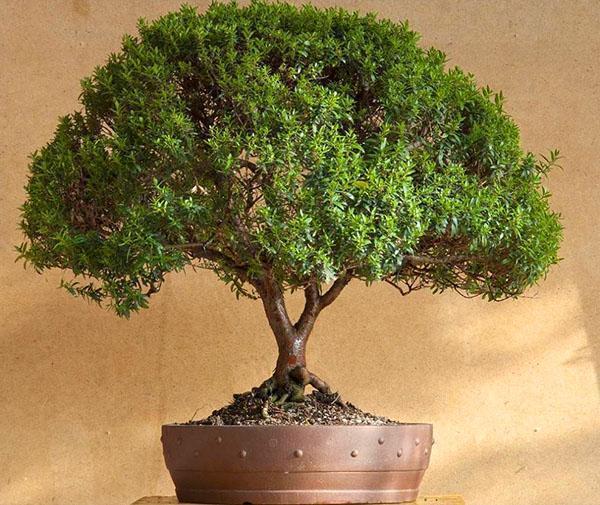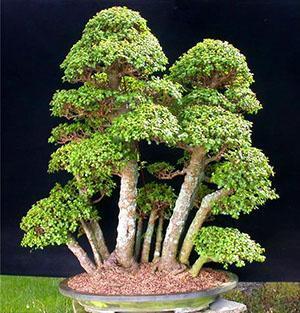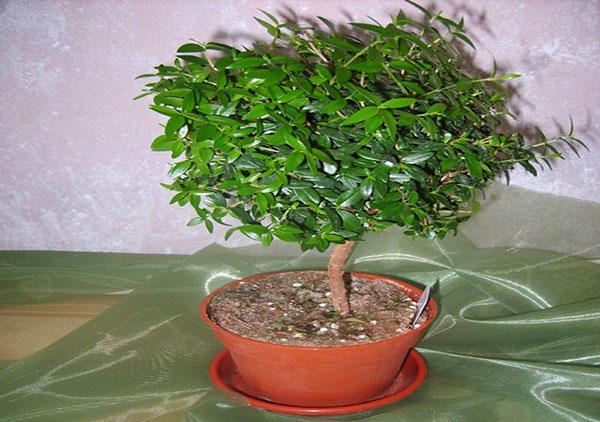A plant of amazing beauty and benefits - common myrtle
 Common myrtle is an evergreen plant, sung in myths. It conquers with the aroma of flowers, shiny green leaves and the ability to create a bush, tree or bonsai from it at home. In the closed circuit of greenhouses, apartments, offices, the common myrtle flower is grown. It is believed that this is a paradise tree that has taken root on earth.
Common myrtle is an evergreen plant, sung in myths. It conquers with the aroma of flowers, shiny green leaves and the ability to create a bush, tree or bonsai from it at home. In the closed circuit of greenhouses, apartments, offices, the common myrtle flower is grown. It is believed that this is a paradise tree that has taken root on earth.
What conquered the myrtle of indoor florists

Many years will pass, it will take jewelry work before the master creates such a miracle from a bush. This is art. But it is not easy to grow a simple fragrant bush of myrtle. In Germany, every girl used to take care of her tree from a very young age. When she got married, the flower became the talisman of a young family. The more beautiful the myrtle was, the more family happiness was prophesied to this family. Such an understanding could also be a subtext. If the girl has already found an approach to the flower, she will also understand her husband, tame her, and there will be happiness in the family.
Myrtle is known as a cult plant not only in ancient Greece. It is a symbol of marital fidelity, peace and quiet in the house and now. Wedding wreaths made of myrtle ropes and roses symbolize the loyalty of the spouses.
Myrtle brings health to the house. Culture leaves give off a pleasant smell, flowers are fragrant. Scientists have determined that a small bush destroys up to 80% of the microbes flying in the air. The smell of a flower has a calming effect on all the inhabitants of the room - it pacifies!
For colds, steam inhalation with leaves of common myrtle is useful. And when the plant blooms with white and pinkish flowers, it is impossible to look away from it. Its dried berries are a spice.
Read also the article: myrtle - home care!
Myrtle ordinary, caring for him at home
 It is not easy to create conditions under which a plant thrives by sharing a home with a person. And myrtle is a special plant. It requires love and care more than other windowsill residents.
It is not easy to create conditions under which a plant thrives by sharing a home with a person. And myrtle is a special plant. It requires love and care more than other windowsill residents.
The main task for the development of a flower is the ability to provide it with a cold winter. In a city apartment with central heating, there is hardly a bright corner with a temperature of about 10 degrees. A closed loggia or balcony can save the situation, where in winter you can keep the common myrtle plant.
Let's start with the fact that we bought a flower in a store grown in distant Holland. A beautiful tree conquered with its bright foliage, healthy appearance.
But a little time passed, and it became clear that the leaves began to dry out and fall off. And although there are many of them, the bush is still fluffy, but the urgent need to see what is with the roots made you take it out carefully from the container. There, among the tangle of tangled roots, there was almost no earth. An incomprehensible composition, similar to household waste and granules of some substance, probably the fertilizer that the plant feeds on.It is necessary to transplant myrtle, this is a common practice for all purchased flowers, replant after two weeks of quarantine.
Caring for common myrtle includes the following steps:
- transfer;
- trimming;
- lighting;
- content temperature;
- mode of watering, wetting leaves, fertilizing;
- elimination of the problems encountered.
The plant is transplanted into a pot with a good drainage hole. The pot is taken larger than the one in which the plant settled down. The roots are freed from the substrate and planted in new soil of the desired composition. Do not bury the trunk. Create a drainage layer of at least 5 cm. The composition of the soil consists of half of sod land, the second half is equal shares of peat, sand and humus. In the future, a flower transplant should be done by the transshipment method, if the myrtle does not dry out and the roots are healthy.
 Trimming or pinching the growing crown is necessary so that the branches do not stretch and the plant is compact. After pruning in spring, the plant quickly releases young foliage and begins to bloom.
Trimming or pinching the growing crown is necessary so that the branches do not stretch and the plant is compact. After pruning in spring, the plant quickly releases young foliage and begins to bloom.
The cut off tops can be rooted to produce young myrtles. Cuttings are germinated in water, then placed in light soil under a hood until new leaves begin to release.
The room where the common myrtle is kept should be bright, with good air exchange. Direct rays of the sun will dry the foliage and it will begin to fall off. In summer, the plant loves to be outdoors. In winter, the room should also be bright, cool, with high humidity.
Water the plant sparingly, but often so that the ground is constantly moist, but not wet. The water must be free of chlorine and hardness salts. It is best if it is filtered in a jug with carbon cartridges. Regular spraying and a moss pan will help keep the moisture around the myrtle.
Myrtha ordinary should not be allocated a place in the bedroom. Its essential oils are energizing and restful sleep will be disturbed. For the same reason, you should not use myrtle drugs at night.
Twice a month during the warm period, from March, you need to do fertilizing watering universal fertilizers... If a green tree is grown or a bonsai is formed, fertilizers are taken for ornamental indoor plants. For a flowering bush, you need to take a different composition, with a predominance of phosphoric salt.
 The plant revolts and sheds foliage if the following conditions are created for it:
The plant revolts and sheds foliage if the following conditions are created for it:
- sun rays, burning the crown;
- non-observance of the water regime and microclimate;
- wintering in a warm place;
- lack of light in summer and winter;
He regards all this as a lack of love and sheds the leaves.
Is it possible to reanimate a dying plant
 As soon as the drying, falling leaves become noticeable, you need to arm yourself with a magnifying glass. Perhaps a spider mite has wound up on your flower. The first sign will be yellowing of individual leaves. It can settle if the leaves are rarely moistened, and the air in the room is dry. If the yellowing of the leaves is massive, then the reason may be overflow and decay of the roots.
As soon as the drying, falling leaves become noticeable, you need to arm yourself with a magnifying glass. Perhaps a spider mite has wound up on your flower. The first sign will be yellowing of individual leaves. It can settle if the leaves are rarely moistened, and the air in the room is dry. If the yellowing of the leaves is massive, then the reason may be overflow and decay of the roots.
If there are live twigs, the plant needs to be reanimated. First of all, revise the roots, remove all damaged ones. Sprinkle the cuts with crushed coal, then Kornevin. Free the ground part from leaves, perform deep pruning. Leave only live branches. Take light soil for planting so that it does not hold water. Do frequent watering with water with micro doses of Kornevin. And wait, perhaps the plant will come to life. It is better not to bring the flower to such a state.